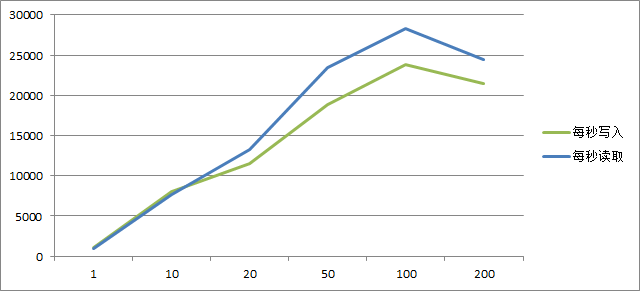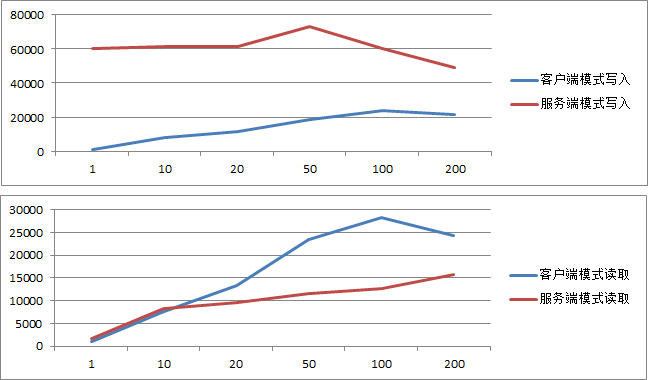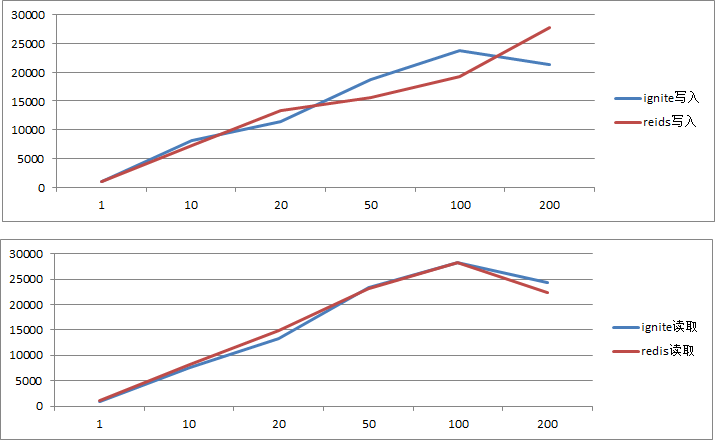共计 11895 个字符,预计需要花费 30 分钟才能阅读完成。
测试方法
为了对 Ignite 做一个基本了解,做了一个性能测试,测试方法也比较简单主要是针对 client 模式,因为这种方法和使用 redis 的方式特别像。测试方法很简单主要是下面几点:
- 不作参数优化,默认配置进行测试
- 在一台 linux 服务器上部署 Ignite 服务端,然后自己的笔记本作客户端
- 按 1,10,20,50,100,200 线程进行测试
测试环境说明
服务器:
[09:36:56] ver. 1.7.0#20160801-sha1:383273e3
[09:36:56] OS: Linux 2.6.32-279.el6.x86_64 amd64
[09:36:56] VM information: Java(TM) SE Runtime Environment 1.7.0_07-b10 Oracle Corporation Java HotSpot(TM) 64-Bit Server VM 23.3-b01
[09:36:56] Configured plugins:
[09:36:56] ^-- None
[09:36:56]
[09:36:56] Security status [authentication=off, tls/ssl=off]CPU:4 核
内存 8GB
网卡 100M
虚拟机
客户机:
[13:05:32] ver. 1.7.0#20160801-sha1:383273e3
[13:05:32] OS: Windows 7 6.1 amd64
[13:05:32] VM information: Java(TM) SE Runtime Environment 1.8.0_40-b26 Oracle Corporation Java HotSpot(TM) 64-Bit Server VM 25.40-b25
[13:05:32] Initial heap size is 128MB (should be no less than 512MB, use -Xms512m -Xmx512m).
[13:05:34] Configured plugins:
[13:05:34] ^-- None
[13:05:34]
[13:05:35] Security status [authentication=off, tls/ssl=off]
[13:05:51] Performance suggestions for grid (fix if possible)
[13:05:51] To disable, set -DIGNITE_PERFORMANCE_SUGGESTIONS_DISABLED=true
[13:05:51] ^-- Decrease number of backups (set 'backups' to 0)CPU:4 核,i5-4210u
内存 8GB
笔记本 win7 64 位
网卡:100M
测试代码
package org.j2server.j2cache.cache.iginte;
import java.util.Arrays;
import org.apache.ignite.Ignite;
import org.apache.ignite.IgniteCache;
import org.apache.ignite.Ignition;
import org.apache.ignite.cache.CacheMode;
import org.apache.ignite.configuration.CacheConfiguration;
import org.apache.ignite.configuration.IgniteConfiguration;
import org.apache.ignite.spi.discovery.tcp.TcpDiscoverySpi;
import org.apache.ignite.spi.discovery.tcp.ipfinder.vm.TcpDiscoveryVmIpFinder;
public class IgniteTest {// 测试的数据行数
private static final Integer test_rows = 50000;
private static final Integer thread_cnt = 10;
private static final String cacheName = "Ignite Cache";
private static Ignite ignite;
private static boolean client_mode = false;
static {getIgnite();
}
public static void main(String[] args) {MultiThread();
}
private static Ignite getIgnite() {if (ignite == null) {TcpDiscoverySpi spi = new TcpDiscoverySpi();
TcpDiscoveryVmIpFinder ipFinder = new TcpDiscoveryVmIpFinder();
ipFinder.setAddresses(Arrays.asList("192.168.49.204"));
spi.setIpFinder(ipFinder);
CacheConfiguration cacheConfiguration = new CacheConfiguration<String, DataClass>();
cacheConfiguration.setCacheMode(CacheMode.PARTITIONED);
cacheConfiguration.setBackups(1);
IgniteConfiguration cfg = new IgniteConfiguration();
cfg.setClientMode(client_mode);
cfg.setDiscoverySpi(spi);
cfg.setCacheConfiguration(cacheConfiguration);
ignite = Ignition.start(cfg);
}
System.out.println("是否客户端模式:" + client_mode);
return ignite;
}
private static void MultiThread() {System.out.println("==================================================================");
System.out.println("开始测试多线程写入[线程数:"+thread_cnt+"]");
Long startTime = System.currentTimeMillis();
Thread[] threads = new Thread[thread_cnt];
Ignite ignite = getIgnite();
IgniteCache<String, DataClass> cache = ignite.getOrCreateCache(cacheName);
for (int i = 0; i < threads.length; i++) {threads[i] = new Thread(new TestThread(true, cache));
}
for (int i = 0; i< threads.length; i++) {threads[i].start();}
for(Thread thread : threads){try {thread.join();
} catch (InterruptedException e) {e.printStackTrace();
}
}
Long endTime=System.currentTimeMillis(); // 获取结束时间
float interval = endTime-startTime == 0 ? 1 : endTime-startTime;
float tpms = (float)test_rows/interval;
System.out.println("程序运行时间:"+ interval+"ms");
System.out.println("每毫秒写入:"+tpms+"条。");
System.out.println("每秒写入:"+tpms*1000+"条。");
System.out.println("==================================================================");
System.out.println("开始测试多线程读取[线程数:"+thread_cnt+"]");
startTime = System.currentTimeMillis();
Thread[] readthreads = new Thread[thread_cnt];
for (int i = 0; i < readthreads.length; i++) {readthreads[i] = new Thread(new TestThread(false, cache));
}
for (int i = 0; i< readthreads.length; i++) {readthreads[i].start();}
for(Thread thread : readthreads){try {thread.join();
} catch (InterruptedException e) {e.printStackTrace();
}
}
endTime=System.currentTimeMillis(); // 获取结束时间
interval = endTime-startTime == 0 ? 1 : endTime-startTime;
tpms = (float)test_rows/interval;
System.out.println("程序运行时间:"+ interval+"ms");
System.out.println("每毫秒读取:"+tpms+"条。");
System.out.println("每秒读取:"+tpms*1000+"条。");
}
static class TestThread implements Runnable {private boolean readMode = true;
private IgniteCache<String, DataClass> cache;
public TestThread(boolean readMode, IgniteCache<String, DataClass> cache){this.readMode = readMode;
this.cache = cache;
}
@Override
public void run() {for (int i = 0; i < test_rows/thread_cnt; i++) {if (this.readMode) {cache.get(Integer.toString(i));
} else {DataClass dc = new DataClass();
dc.setName(Integer.toString(i));
dc.setValue(i);
dc.setStrValue("asdfadsfasfda");
cache.put(Integer.toString(i), dc);
}
}
}
}
}
import java.io.Serializable;
public class DataClass implements Serializable{private String name;
private long value;
private String strValue;
public String getName() {return name;
}
public void setName(String name) {this.name = name;
}
public long getValue() {return value;
}
public void setValue(long value) {this.value = value;
}
public String getStrValue() {return strValue;
}
public void setStrValue(String strValue) {this.strValue = strValue;
}
}测试数据
最终测试的结果还是有点意思,随着线程的增长读写性能大幅提升,但是到了 200 的时候就开始下降。下面是测试数据:
[12:53:40] Topology snapshot [ver=20, servers=1, clients=1, CPUs=8, heap=2.8GB]
==================================================================
开始测试多线程写入[线程数:1]
程序运行时间:49066.0ms
每毫秒写入:1.0190356条。每秒写入:1019.0356条。==================================================================
开始测试多线程读取[线程数:1]
程序运行时间:51739.0ms
每毫秒读取:0.966389条。每秒读取:966.389条。[12:56:22] Topology snapshot [ver=22, servers=1, clients=1, CPUs=8, heap=2.8GB]
==================================================================
开始测试多线程写入[线程数:10]
程序运行时间:6215.0ms
每毫秒写入:8.045053条。每秒写入:8045.0527条。==================================================================
开始测试多线程读取[线程数:10]
程序运行时间:6526.0ms
每毫秒读取:7.661661条。每秒读取:7661.661条。[12:57:04] Topology snapshot [ver=24, servers=1, clients=1, CPUs=8, heap=2.8GB]
==================================================================
开始测试多线程写入[线程数:20]
程序运行时间:4353.0ms
每毫秒写入:11.486331条。每秒写入:11486.331条。==================================================================
开始测试多线程读取[线程数:20]
程序运行时间:3768.0ms
每毫秒读取:13.269639条。每秒读取:13269.639条。[12:57:34] Topology snapshot [ver=26, servers=1, clients=1, CPUs=8, heap=2.8GB]
==================================================================
开始测试多线程写入[线程数:50]
程序运行时间:2657.0ms
每毫秒写入:18.818216条。每秒写入:18818.217条。==================================================================
开始测试多线程读取[线程数:50]
程序运行时间:2138.0ms
每毫秒读取:23.386343条。每秒读取:23386.344条。[12:58:00] Topology snapshot [ver=28, servers=1, clients=1, CPUs=8, heap=2.8GB]
==================================================================
开始测试多线程写入[线程数:100]
程序运行时间:2095.0ms
每毫秒写入:23.866348条。每秒写入:23866.348条。==================================================================
开始测试多线程读取[线程数:100]
程序运行时间:1764.0ms
每毫秒读取:28.344671条。每秒读取:28344.672条。[12:59:19] Topology snapshot [ver=30, servers=1, clients=1, CPUs=8, heap=2.8GB]
==================================================================
开始测试多线程写入[线程数:200]
程序运行时间:2333.0ms
每毫秒写入:21.431633条。每秒写入:21431.633条。==================================================================
开始测试多线程读取[线程数:200]
程序运行时间:2049.0ms
每毫秒读取:24.402147条。每秒读取:24402.146条。用图形看看比较直观
不使用客户端模式
只不过我发现如果不使用 client_mode,也就是都是 server 模式时写入性能还是很强的,但是读取有点搓。
[14:15:02] Topology snapshot [ver=22, servers=2, clients=0, CPUs=8, heap=2.8GB]
是否客户端模式:false
==================================================================
开始测试多线程写入[线程数:1]
是否客户端模式:false
程序运行时间:828.0ms
每毫秒写入:60.386475条。每秒写入:60386.477条。==================================================================
开始测试多线程读取[线程数:1]
程序运行时间:28819.0ms
每毫秒读取:1.7349665条。每秒读取:1734.9666条。[14:08:55] Topology snapshot [ver=10, servers=2, clients=0, CPUs=8, heap=2.8GB]
是否客户端模式:false
==================================================================
开始测试多线程写入[线程数:10]
是否客户端模式:false
程序运行时间:813.0ms
每毫秒写入:61.500614条。每秒写入:61500.613条。==================================================================
开始测试多线程读取[线程数:10]
程序运行时间:5965.0ms
每毫秒读取:8.38223条。每秒读取:8382.2295条。[14:09:48] Topology snapshot [ver=12, servers=2, clients=0, CPUs=8, heap=2.8GB]
是否客户端模式:false
==================================================================
开始测试多线程写入[线程数:20]
是否客户端模式:false
程序运行时间:812.0ms
每毫秒写入:61.576355条。每秒写入:61576.355条。==================================================================
开始测试多线程读取[线程数:20]
程序运行时间:5157.0ms
每毫秒读取:9.6955595条。每秒读取:9695.56条。[14:10:25] Topology snapshot [ver=14, servers=2, clients=0, CPUs=8, heap=2.8GB]
是否客户端模式:false
==================================================================
开始测试多线程写入[线程数:50]
是否客户端模式:false
程序运行时间:686.0ms
每毫秒写入:72.8863条。每秒写入:72886.3条。==================================================================
开始测试多线程读取[线程数:50]
程序运行时间:4321.0ms
每毫秒读取:11.571396条。每秒读取:11571.3955条。[14:11:01] Topology snapshot [ver=16, servers=2, clients=0, CPUs=8, heap=2.8GB]
是否客户端模式:false
==================================================================
开始测试多线程写入[线程数:100]
是否客户端模式:false
程序运行时间:830.0ms
每毫秒写入:60.240963条。每秒写入:60240.965条。==================================================================
开始测试多线程读取[线程数:100]
程序运行时间:3963.0ms
每毫秒读取:12.616705条。每秒读取:12616.705条。[14:13:58] Topology snapshot [ver=20, servers=2, clients=0, CPUs=8, heap=2.8GB]
是否客户端模式:false
==================================================================
开始测试多线程写入[线程数:200]
是否客户端模式:false
程序运行时间:1014.0ms
每毫秒写入:49.309666条。每秒写入:49309.664条。==================================================================
开始测试多线程读取[线程数:200]
程序运行时间:3179.0ms
每毫秒读取:15.728216条。每秒读取:15728.216条。用图形看看比较直观
从这个数据可以看出来,在这种都是服务端的模式下,写入性能基本稳定,在达到 200 线程时出现衰减;而读取则基本是线性的,到 100 线程差不多也就到顶了。
与 redis 的对比
原本是想和 redis 作一个对比测试的,先是做了 redis 的测试。redis 客户端用的 jedis2.8.1,同时服务端用的是 redis3.2.2,其他的环境和上面的一样。
结果测试数据发现 redis 和 ignite 使用客户端模式时竟然很相近。所以我怀疑是因为我对 redis 不了解 redis 没作优化导致的?但是 Ignite 我也是直接启动的,一点优化也没作,还是说测试的代码写法不对呢?
下面是 redis 的测试代码
import redis.clients.jedis.Jedis;
public class redis {private static final String ip = "192.168.49.200";
private static final String auth = "your pwd";
private static final Integer port = 6379;
// 测试的数据行数
private static final Integer test_rows = 50000;
// 线程数
private static final Integer thread_cnt = 200;
public static void main(String[] args) {MultiThread();
}
private static void MultiThread() {System.out.println("==================================================================");
System.out.println("开始测试多线程写入[线程数:"+thread_cnt+"]");
Long startTime = System.currentTimeMillis();
Thread[] threads = new Thread[thread_cnt];
for (int i = 0; i < threads.length; i++) {threads[i] = new Thread(new TestThread(true));
}
for (int i = 0; i< threads.length; i++) {threads[i].start();}
for(Thread thread : threads){try {thread.join();} catch (InterruptedException e) {e.printStackTrace();
}
}
Long endTime=System.currentTimeMillis(); // 获取结束时间
float interval = endTime-startTime == 0 ? 1 : endTime-startTime;
float tpms = (float)test_rows/interval;
System.out.println("程序运行时间:"+ interval+"ms");
System.out.println("每毫秒写入:"+tpms+"条。");
System.out.println("每秒写入:"+tpms*1000+"条。");
System.out.println("==================================================================");
System.out.println("开始测试多线程写入[线程数:"+thread_cnt+"]");
startTime = System.currentTimeMillis();
Thread[] readthreads = new Thread[thread_cnt];
for (int i = 0; i < readthreads.length; i++) {readthreads[i] = new Thread(new TestThread(false));
}
for (int i = 0; i< readthreads.length; i++) {readthreads[i].start();}
for(Thread thread : readthreads){try {thread.join();} catch (InterruptedException e) {e.printStackTrace();
}
}
endTime=System.currentTimeMillis(); // 获取结束时间
interval = endTime-startTime == 0 ? 1 : endTime-startTime;
tpms = (float)test_rows/interval;
System.out.println("程序运行时间:"+ interval+"ms");
System.out.println("每毫秒读取:"+tpms+"条。");
System.out.println("每秒读取:"+tpms*1000+"条。");
}
static class TestThread implements Runnable {private boolean readMode = true;
public TestThread(boolean readMode){this.readMode = readMode;
}
@Override
public void run() {Jedis j = new Jedis(ip,port);
j.auth(auth);
for (int i = 0; i < test_rows/thread_cnt; i++) {if (this.readMode) {j.get("foo"+i);
} else {j.set("foo"+i, "bar"+i);
}
}
j.disconnect();}
}
}对比结果视图
结束
原本我想着 redis 估计得秒了 ignite,毕竟 redis 是这么多系统正在使用的内存数据库。ignite 本身含有这么多功能按理性能肯定是比不上才对,而且 ignite 组成集群后是需要进行数据分块存取和备份的,而测试环境中 redis 则是单实例情况,这让我没太想明白啊。。还望有高手指点。。
看网上许多人测试的数据 redis 少点的 4 万 +,据说可以到 10 万 +。但我自己的测试环境差了点反正最多也没过 3 万,这到底会是什么原因呢?
不管如何这是一次简单的测试与尝试,结果与预期有点偏差,继续学习深入了解吧。
本文永久更新链接地址:http://www.linuxidc.com/Linux/2016-11/137475.htm





















